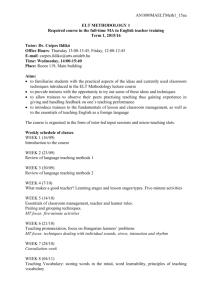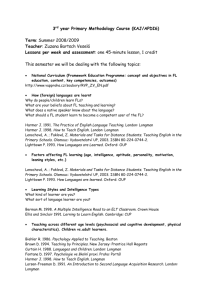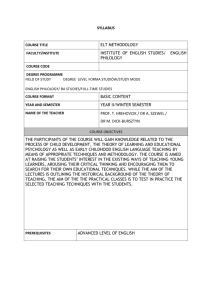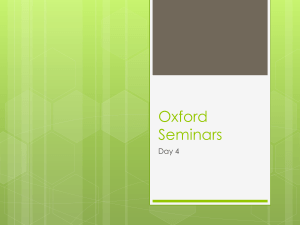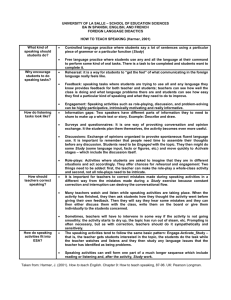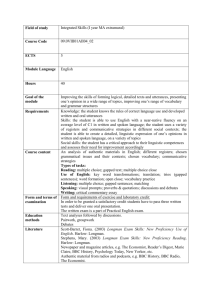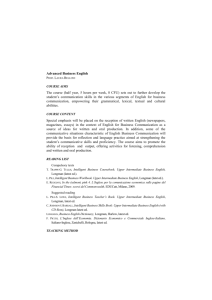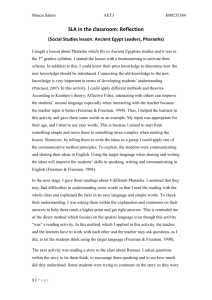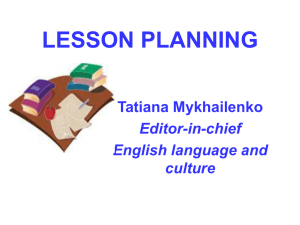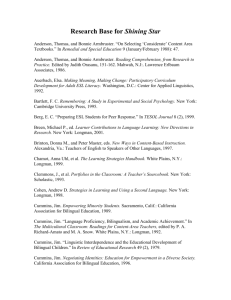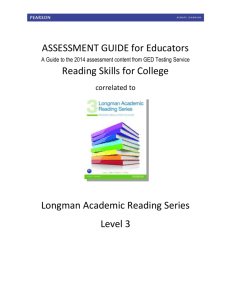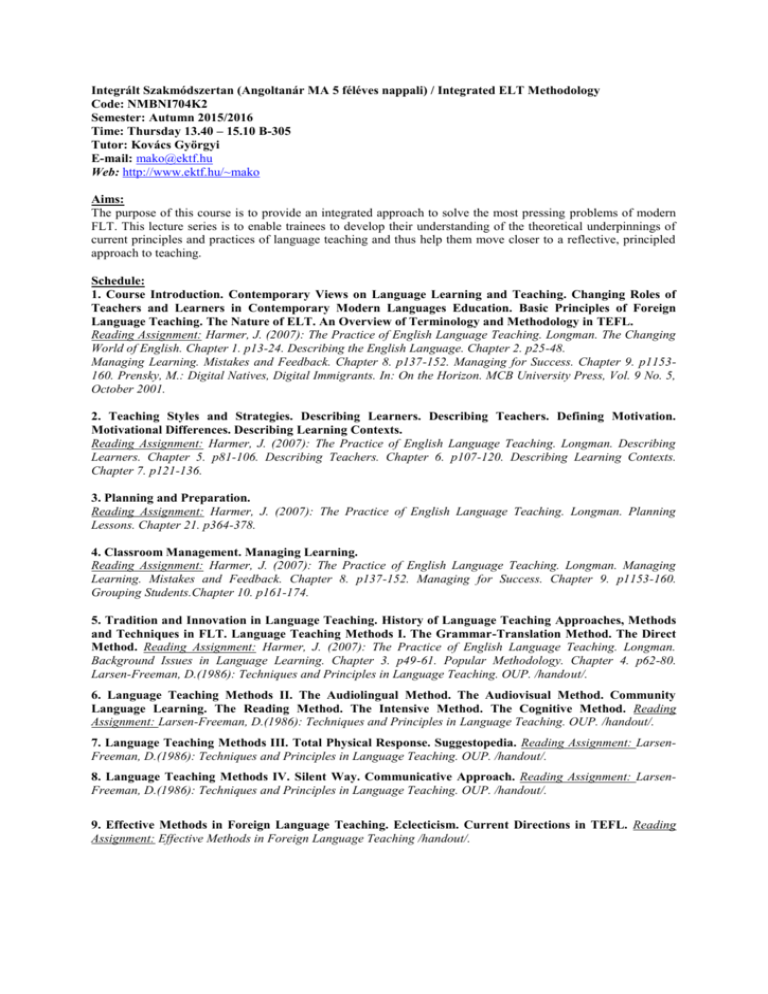
Integrált Szakmódszertan (Angoltanár MA 5 féléves nappali) / Integrated ELT Methodology
Code: NMBNI704K2
Semester: Autumn 2015/2016
Time: Thursday 13.40 – 15.10 B-305
Tutor: Kovács Györgyi
E-mail: mako@ektf.hu
Web: http://www.ektf.hu/~mako
Aims:
The purpose of this course is to provide an integrated approach to solve the most pressing problems of modern
FLT. This lecture series is to enable trainees to develop their understanding of the theoretical underpinnings of
current principles and practices of language teaching and thus help them move closer to a reflective, principled
approach to teaching.
Schedule:
1. Course Introduction. Contemporary Views on Language Learning and Teaching. Changing Roles of
Teachers and Learners in Contemporary Modern Languages Education. Basic Principles of Foreign
Language Teaching. The Nature of ELT. An Overview of Terminology and Methodology in TEFL.
Reading Assignment: Harmer, J. (2007): The Practice of English Language Teaching. Longman. The Changing
World of English. Chapter 1. p13-24. Describing the English Language. Chapter 2. p25-48.
Managing Learning. Mistakes and Feedback. Chapter 8. p137-152. Managing for Success. Chapter 9. p1153160. Prensky, M.: Digital Natives, Digital Immigrants. In: On the Horizon. MCB University Press, Vol. 9 No. 5,
October 2001.
2. Teaching Styles and Strategies. Describing Learners. Describing Teachers. Defining Motivation.
Motivational Differences. Describing Learning Contexts.
Reading Assignment: Harmer, J. (2007): The Practice of English Language Teaching. Longman. Describing
Learners. Chapter 5. p81-106. Describing Teachers. Chapter 6. p107-120. Describing Learning Contexts.
Chapter 7. p121-136.
3. Planning and Preparation.
Reading Assignment: Harmer, J. (2007): The Practice of English Language Teaching. Longman. Planning
Lessons. Chapter 21. p364-378.
4. Classroom Management. Managing Learning.
Reading Assignment: Harmer, J. (2007): The Practice of English Language Teaching. Longman. Managing
Learning. Mistakes and Feedback. Chapter 8. p137-152. Managing for Success. Chapter 9. p1153-160.
Grouping Students.Chapter 10. p161-174.
5. Tradition and Innovation in Language Teaching. History of Language Teaching Approaches, Methods
and Techniques in FLT. Language Teaching Methods I. The Grammar-Translation Method. The Direct
Method. Reading Assignment: Harmer, J. (2007): The Practice of English Language Teaching. Longman.
Background Issues in Language Learning. Chapter 3. p49-61. Popular Methodology. Chapter 4. p62-80.
Larsen-Freeman, D.(1986): Techniques and Principles in Language Teaching. OUP. /handout/.
6. Language Teaching Methods II. The Audiolingual Method. The Audiovisual Method. Community
Language Learning. The Reading Method. The Intensive Method. The Cognitive Method. Reading
Assignment: Larsen-Freeman, D.(1986): Techniques and Principles in Language Teaching. OUP. /handout/.
7. Language Teaching Methods III. Total Physical Response. Suggestopedia. Reading Assignment: LarsenFreeman, D.(1986): Techniques and Principles in Language Teaching. OUP. /handout/.
8. Language Teaching Methods IV. Silent Way. Communicative Approach. Reading Assignment: LarsenFreeman, D.(1986): Techniques and Principles in Language Teaching. OUP. /handout/.
9. Effective Methods in Foreign Language Teaching. Eclecticism. Current Directions in TEFL. Reading
Assignment: Effective Methods in Foreign Language Teaching /handout/.
10. Teaching vs. Assessment. Mistakes and Errors in Language Learning. Feedback and Alternative
Assessment.
Reading Assignment: Harmer, J. (2007): The Practice of English Language Teaching. Longman. Mistakes and
Feedback. Chapter 8. p137-152. Testing and Evaluation. Chapter 22. p379-393. Learner Autonomy: Learning to
Learn. Chapter 23. p394-409. What Teachers Do Next. Chapter24. p410-428.
11. Testing and Evaluation.
Reading Assignment: Harmer, J. (2007): The Practice of English Language Teaching. Longman. Testing and
Evaluation. Chapter 22. p379-393.
12. Learner Autonomy and Teacher Development.
Reading Assignment: Harmer, J. (2007): The Practice of English Language Teaching. Longman. Learner
Autonomy: Learning to Learn. Chapter 23. p394-409. What Teachers Do Next. Chapter24. p410-428.
13. Cultures in Conflict: The EFL Classroom in Hungarian Schools. Foreign Language Education Policy
and FL Projects in Hungary. Cross-curricular Approach in Languages Education. Immersion Education.
Content-Based Curriculum. Project-oriented Language Education. Reading Assignment:English language
Education in Hungary I-III.. A Baseline Study. General Editor: Nikolov Marianne. British Council Hungary.
Medgyes, P. (2011): Aranykor. Nyelvoktatásunk két évtizede. 1989-2009. Nemzeti Tankönyvkiadó.
Assessment:
Assessment will be based on a written exam, a test which will be comprised of the lecture content and the set
readings.
Recommended Reading:
Brown, H.D. (2007): Principles of Language Learning and Teaching. Pearson Longman.
Brown, H.D.: Teaching by Principles. An Interactive Approach to L.P. Longman, 2001.
Harmer, J. (2007): The Practice of English Language Teaching. Longman. 4th edition.
Haycraft, J. (1993): An Introduction to English Language Teaching. Longman
Howatt, A. (1984): A History of English Language Teaching. Oxford University Press.
Hubbard et al. (1991): A Training Course for TEFL. Oxford University Press.
Larsen – Freeman, D. (1986): Techniques and Principles in Language Teaching. OUP.
Medgyes, P. (1997): A nyelvtanár. A nyelvtanítás módszertana. Corvina.
Medgyes, P. (2011): Aranykor. Nyelvoktatásunk két évtizede. 1989-2009. Nemzeti Tankönyvkiadó.
Mehisto, P. – Marsh, D. – Frigols, M.J.: Unvovering CLIL. Content and Language Integrated Learning in
Bilingual and Multilingual Education. Macmillan, 2008.
Prensky, M.: Digital Natives, Digital Immigrants. In: On the Horizon. MCB University Press, Vol. 9 No. 5,
October 2001.
Scrivener, J. (2005): Learning Teaching. Macmillan.

